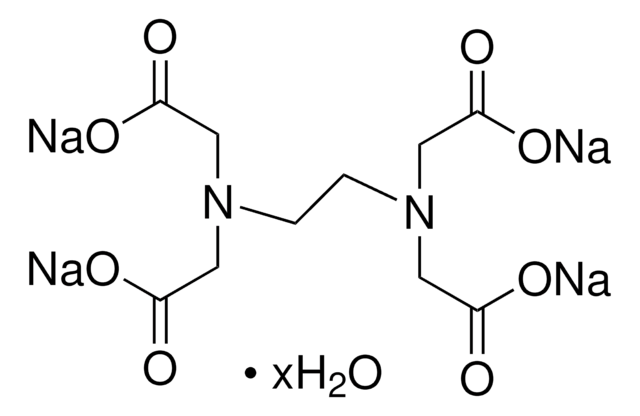Key Documents
03699
Ethylenediaminetetraacetic acid tetrasodium salt hydrate
BioUltra, ≥99.0% (KT)
Synonim(y):
EDTA tetrasodium salt, Edathamil, Tetrasodium ethylenediaminetetraacetate hydrate
About This Item
Polecane produkty
linia produktu
BioUltra
Próba
≥99.0% (KT)
Postać
powder
przydatność reakcji
reagent type: chelator
zanieczyszczenia
insoluble matter, passes filter test
pH
11.0-12.0 (25 °C, 0.1 M in H2O)
rozpuszczalność
H2O: 0.1 M at 20 °C, clear, colorless
ślady anionów
chloride (Cl-): ≤100 mg/kg
sulfate (SO42-): ≤100 mg/kg
ślady kationów
Al: ≤5 mg/kg
As: ≤0.1 mg/kg
Ba: ≤5 mg/kg
Bi: ≤5 mg/kg
Ca: ≤10 mg/kg
Cd: ≤5 mg/kg
Co: ≤5 mg/kg
Cr: ≤5 mg/kg
Cu: ≤5 mg/kg
Fe: ≤5 mg/kg
K: ≤50 mg/kg
Li: ≤5 mg/kg
Mg: ≤5 mg/kg
Mn: ≤5 mg/kg
Mo: ≤5 mg/kg
Ni: ≤5 mg/kg
Pb: ≤5 mg/kg
Sr: ≤5 mg/kg
Zn: ≤5 mg/kg
λ
0.1 M in H2O
absorpcja UV
λ: 260 nm Amax: ≤1.5
λ: 280 nm Amax: ≤0.06
ciąg SMILES
O.[Na+].[Na+].[Na+].[Na+].[O-]C(=O)CN(CCN(CC([O-])=O)CC([O-])=O)CC([O-])=O
InChI
1S/C10H16N2O8.4Na.H2O/c13-7(14)3-11(4-8(15)16)1-2-12(5-9(17)18)6-10(19)20;;;;;/h1-6H2,(H,13,14)(H,15,16)(H,17,18)(H,19,20);;;;;1H2/q;4*+1;/p-4
Klucz InChI
GXFFSKMBMYHTAE-UHFFFAOYSA-J
Szukasz podobnych produktów? Odwiedź Przewodnik dotyczący porównywania produktów
Zastosowanie
Uwaga dotycząca przygotowania
Hasło ostrzegawcze
Danger
Zwroty wskazujące rodzaj zagrożenia
Zwroty wskazujące środki ostrożności
Klasyfikacja zagrożeń
Acute Tox. 4 Inhalation - Acute Tox. 4 Oral - Eye Dam. 1 - STOT RE 2
Organy docelowe
Respiratory Tract
Kod klasy składowania
11 - Combustible Solids
Klasa zagrożenia wodnego (WGK)
WGK 2
Temperatura zapłonu (°F)
Not applicable
Temperatura zapłonu (°C)
Not applicable
Środki ochrony indywidualnej
dust mask type N95 (US), Eyeshields, Gloves
Certyfikaty analizy (CoA)
Poszukaj Certyfikaty analizy (CoA), wpisując numer partii/serii produktów. Numery serii i partii można znaleźć na etykiecie produktu po słowach „seria” lub „partia”.
Masz już ten produkt?
Dokumenty związane z niedawno zakupionymi produktami zostały zamieszczone w Bibliotece dokumentów.
Klienci oglądali również te produkty
Nasz zespół naukowców ma doświadczenie we wszystkich obszarach badań, w tym w naukach przyrodniczych, materiałoznawstwie, syntezie chemicznej, chromatografii, analityce i wielu innych dziedzinach.
Skontaktuj się z zespołem ds. pomocy technicznej







